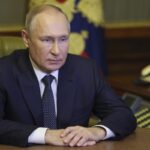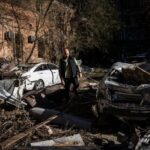
*
Protesters are calling for end to clerical rule
*
Social media show tanks being moved to Kurdish regions
*
Iran blames Iranian Kurdish dissidents for some unrest
*
Protests spread to vital energy sector
(Adds report from Kurdish human rights organisation, other details)
DUBAI, Oct 11 (Reuters) –
Clashes between protesters and security forces persisted across Iran on Tuesday, with social media videos showing tanks being transported to Kurdish areas, which have been a focal point of the crackdown on protests over Mahsa Amini’s death in custody.
Protests calling for the fall of the clerical establishment have swept Iran since Amini, a 22-year-old Iranian Kurdish woman, died on Sept. 16 while being detained by the morality police in Tehran for “inappropriate attire”.
While observers do not believe the unrest is close to toppling the government, the protests mark one of the boldest challenges to the Islamic Republic since the 1979 revolution, with reports of strikes spreading to the vital energy sector.
The authorities are waging a deadly crackdown. Videos on social media showed trucks moving dark green tanks to Kurdish areas, raising the stakes in the revolt. Reuters could not verify the video footage.
At least 185 people, including 19 minors, have been killed, hundreds injured and thousands have been arrested by the security forces, according to rights groups. The government says more than 20 members of the security forces have been killed.
Iranian authorities have said they will investigate civilian deaths.
Tensions have been especially high in Kurdish regions, given Amini’s ethnic background. Human rights groups say Iran’s Kurdish minority of more than 10 million has long been oppressed – a charge the Islamic Republic denies.
The Kurdistan Human Rights Network said the protests were continuing for a fourth week in those regions “despite the tense security atmosphere and the militarization of these cities”.
It said security forces had killed at least 30 protesters, injured another 825, and arrested more than 2,000 in the predominantly Kurdish regions.
Reuters could not independently verify the report.
The Hengaw human rights group said on Monday security forces had fired towards residences in the Kurdish city of Sanandaj.
The Iranian authorities have blamed the violence on an array of enemies including armed Iranian Kurdish dissidents, with the Revolutionary Guards attacking their bases in neighbouring Iraq a number of times during the latest unrest.
Interior Minister Ahmad Vahidi reiterated accusations that Iranian Kurdish dissident groups were supporting the protests and said security forces would “neutralize the desperate anti-revolutionary effort”.
ENERGY SECTOR
Unrest continued elsewhere overnight after demonstrations spread into Iran’s vital energy sector, according to videos on social media which Reuters could not confirm.
Energy installations in southwestern Iran were hit by strikes for a second day on Tuesday, with workers protesting at the Abadan oil refinery, Kangan and the Bushehr petrochemical plant, according to the widely followed Tavsir1500 Twitter account.
Videos posted on the account showed a few dozen workers chanting “Death to the dictator”, referring to Supreme Leader Ayatollah Ali Khamenei.
A regional official said on Tuesday the workers at the Assaluye plant were angered by a dispute over wages and were not protesting over Amini’s death.
Governor Ali Hashemi said some Iranians had tried to hijack the workers’ protests by chanting anti-government slogans, according to Iran’s Young Journalists Club News (YJC) Telegram account.
It was a combination of mass protests and strikes by oil workers and bazaar merchants that helped to propel the Shi’ite clergy to power in the Iranian revolution four decades ago.
Dozens of universities are also currently on strike, with students playing a pivotal role in the protests.
Meanwhile, in the city of Fuladshahr in the central province of Isfahan protesters set fire to the office of a prayer leader, according to a video posted by Tavsir1500.
The authorities’ crackdown on protesters has prompted some Western states to draw up more sanctions on Iran, stoking diplomatic tensions at a time when talks to revive Tehran’s 2015 nuclear deal with world powers are at a standstill.
France’s foreign minister said on Tuesday five of its nationals were being held in Iran and the European Union had agreed the technical aspects to impose sanctions on Tehran, which would come into force next week.
France lashed out at Iran on Oct. 6 accusing it of “dictatorial practices” and taking its citizens hostage after a video was aired in which a French couple appeared to confess to spying. (Reporting by John Irish in Paris and Dubai newsroom: Writing by Michael Georgy/Tom Perry; Editing by Raissa Kasolowsky and Gareth Jones)




